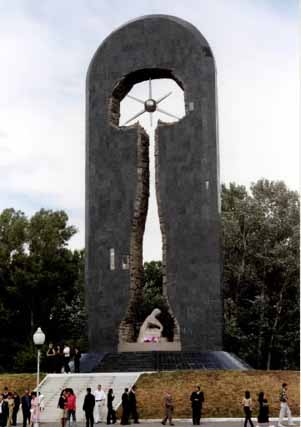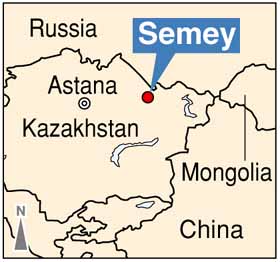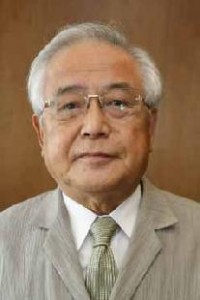Ethnic Koreans in Kazakhstan, Part 1: Deported by the former Soviet Union
Oct. 5, 2008
by Takashi Hiraoka, honorary president of the Hiroshima Semipalatinsk Project and former mayor of Hiroshima
This past summer I again visited Kazakhstan as a member of a research group led by Noriyuki Kawano, research associate at the Research Institute for Radiation Biology and Medicine of Hiroshima University. The group has received Grants-in-Aid for Scientific Research from the Ministry of Education, Culture, Sports, Science and Technology (MEXT).
The aim of the research is to grasp the true nature of the damage caused by nuclear testing in Kazakhstan by speaking with the people living near Semipalatinsk, which has been called “Semey” since 2007.
At the nuclear test site “Polygon” as many as 470 nuclear tests were conducted by the former Soviet Union over a period of 40 years, from August 29, 1949 until 1989, when the test site was closed. It is believed that up to 1 million people were exposed to the radiation released by these nuclear blasts.
Every year, the research group visits villages in Kazakhstan, interviews the people there, and records their experiences. Many of them voice concern over their fear of the invisible effects of radiation, which gradually undermine their health.
I have a particular interest in the life history of these people because it seems that investigating the effects of the damage wrought by nuclear testing on each individual is key to understanding the relationship between nuclear weapons and human beings.
The Kazakh people are not the only victims of nuclear testing by the former Soviet Union. Kazakhstan is a multiethnic country. According to the Korean Association of Kazakhstan, 102,000 ethnic Koreans live there. Near Semey, there are 1470 Korean residents and many of them have received official documentation which recognizes their status as victims of the nuclear testing.
Originally, these ethnic Koreans emigrated to Primorsky Krai, a region in southeastern Russia, to flee their bleak lives amid the Japanese colonial control of their country. They mainly engaged in farming and gained good standing in Russian society.
In the 1930s, as the relationship between the former Soviet Union and Japan became strained, the Soviets grew concerned that the ethnic Koreans might act as spies for Japan. As a result, in the summer of 1937, Joseph Stalin ordered the deportation of the ethnic Koreans. By the end of the year, 75,000 Koreans were sent to the Republic of Uzbekistan and 95,000 to the Republic of Kazakhstan.
Those deported to Kazakhstan were packed in trains and dumped on the wild land in early winter with only the clothes on their back. A great number of elderly and children are believed to have died of cold, hunger, and disease.
Despite the harsh environment, the Korean population managed to endure and cultivated the barren land into fertile farms. Even after the collapse of the Soviet Union, when they could have returned to Primorsky Krai, they chose to remain in Kazakhstan.
The ethnic Koreans call themselves “Koryo Saram,” a Soviet Korean phrase which does not distinguish between the peoples of North and South on the divided Korean peninsula.
(Originally published on September 17, 2008)
Related articles
Youth from Hiroshima to visit Semipalatinsk, former nuclear testing site (Aug. 5, 2008)
HICARE, providing support for victims of radiation exposure for 17 years (March 20, 2008)
This past summer I again visited Kazakhstan as a member of a research group led by Noriyuki Kawano, research associate at the Research Institute for Radiation Biology and Medicine of Hiroshima University. The group has received Grants-in-Aid for Scientific Research from the Ministry of Education, Culture, Sports, Science and Technology (MEXT).
The aim of the research is to grasp the true nature of the damage caused by nuclear testing in Kazakhstan by speaking with the people living near Semipalatinsk, which has been called “Semey” since 2007.
At the nuclear test site “Polygon” as many as 470 nuclear tests were conducted by the former Soviet Union over a period of 40 years, from August 29, 1949 until 1989, when the test site was closed. It is believed that up to 1 million people were exposed to the radiation released by these nuclear blasts.
Every year, the research group visits villages in Kazakhstan, interviews the people there, and records their experiences. Many of them voice concern over their fear of the invisible effects of radiation, which gradually undermine their health.
I have a particular interest in the life history of these people because it seems that investigating the effects of the damage wrought by nuclear testing on each individual is key to understanding the relationship between nuclear weapons and human beings.
The Kazakh people are not the only victims of nuclear testing by the former Soviet Union. Kazakhstan is a multiethnic country. According to the Korean Association of Kazakhstan, 102,000 ethnic Koreans live there. Near Semey, there are 1470 Korean residents and many of them have received official documentation which recognizes their status as victims of the nuclear testing.
Originally, these ethnic Koreans emigrated to Primorsky Krai, a region in southeastern Russia, to flee their bleak lives amid the Japanese colonial control of their country. They mainly engaged in farming and gained good standing in Russian society.
In the 1930s, as the relationship between the former Soviet Union and Japan became strained, the Soviets grew concerned that the ethnic Koreans might act as spies for Japan. As a result, in the summer of 1937, Joseph Stalin ordered the deportation of the ethnic Koreans. By the end of the year, 75,000 Koreans were sent to the Republic of Uzbekistan and 95,000 to the Republic of Kazakhstan.
Those deported to Kazakhstan were packed in trains and dumped on the wild land in early winter with only the clothes on their back. A great number of elderly and children are believed to have died of cold, hunger, and disease.
Despite the harsh environment, the Korean population managed to endure and cultivated the barren land into fertile farms. Even after the collapse of the Soviet Union, when they could have returned to Primorsky Krai, they chose to remain in Kazakhstan.
The ethnic Koreans call themselves “Koryo Saram,” a Soviet Korean phrase which does not distinguish between the peoples of North and South on the divided Korean peninsula.
(Originally published on September 17, 2008)
Related articles
Youth from Hiroshima to visit Semipalatinsk, former nuclear testing site (Aug. 5, 2008)
HICARE, providing support for victims of radiation exposure for 17 years (March 20, 2008)










